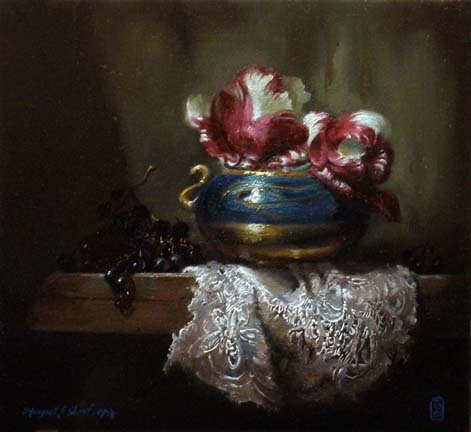Tulips in the Eye of Horus
Sold
10×11 Oil on Linen
© Margret E. Short, OPA, AWA, 2009
Lesssons from the Pharaoh’s Tomb
Lawrence Gallery, Portland, Oregon September & October 2009
Egyptian societies in antiquity were strictly stratified, and the king was the most powerful holder of divine office. When the previous pharaoh died the new ruler became linked with the god of the afterlife,Osiris. The new pharaoh then took over the divine link to living gods, Re, the sun god, and Horus, the falcon headed god.
This gave the new king the link between the common people and all gods and goddesses who ruled their destiny. He was the conduit so to speak. The eye of Horus, known as wedjet to the ancients, has great significance with diverse origins but symbolically means, “to be protected in the eye of Horus.”
I purchased this blue and gold jar at the Khan el Khalili marketplace in Cairo because of both the color and the design which shows the cobra handle and the eye of Horus. There is no evidence so far that tulips were cultivated in Egypt but I can just imagine those lovely flowers growing in a cool green oasis by Cleopatra’s personal gardeners. The flowers were painted using a combination of red iron oxide, madder, and black; the blue of the jar, azurite; the golds, various ochres from Sinopia.
Lawrence Gallery, Portland, Oregon



Love the gold……